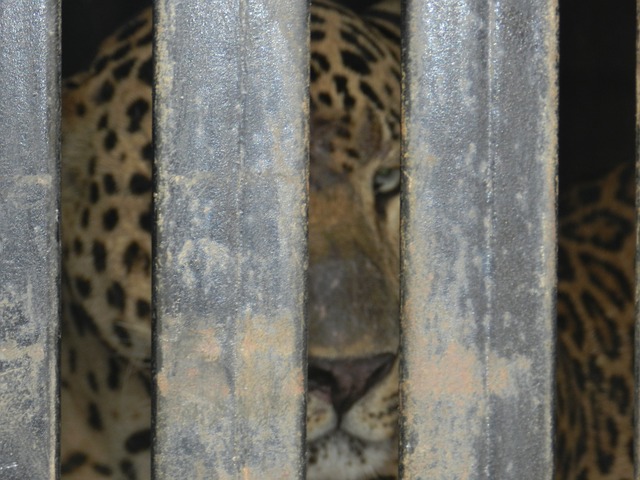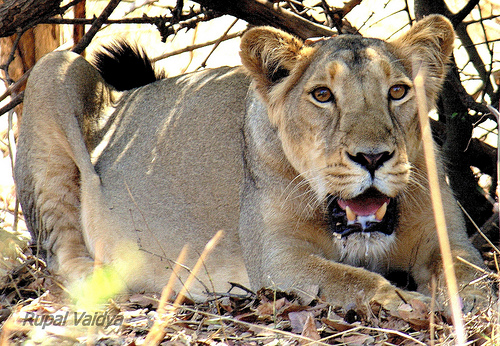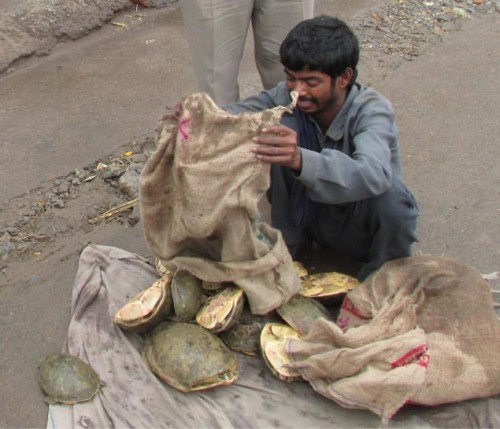As the number of leopard deaths due to the human-leopard conflict continue to rise in India, experts are trying to understand the leopard’s behaviour and think of out-of-the-box ideas to avoid conflict.
“Sing off tune, never mind. Just sing and loud,” advises Puneet Nayyar, Deputy conservator of forest, Surat, Gujarat where leopard-human conflict is on the rise.
Leopards, or for that matter most other animals are not used to listening to the sounds of singing or whistling, says Puneet. He, therefore, asks the villagers to sing or whistle even if they are bad singers.
The forest department of Gujarat has begun a Leopard Ambassador Programme where ambassadors go from village to village teaching the locals non-violent means of avoiding the wild cats. This includes stamping the ground while walking, not going into farms after dusk, keeping a torchlight and singing.
“We have identified that the movement of the leopard is the highest near human habitations in Mandvi and Mangrol taluka of Surat district. Hence the forest department has started the Leopard Ambassador Programme on a trial basis in these talukas,” says Nayyar.
As accidental encounters mostly give rise to violent retaliation from people as well as the animal, the first step is to avoid such encounters, he feels. And it is the people who need this training, not the animal, which is inherently shy and avoids humans even when their paths cross.
Read More: Leopard Cub Rescued in Karnataka
Whether living on the fringes of the forests, farmlands or in deep jungles, leopards rely on their keen sense of sight, hearing and smell to avoid detection. But with the rapidly vanishing wilderness areas, and a vast network of roads or rail tracks breaking continuous forest lands, the leopards have been exposed. As we steal their hiding places, the animals have no choice but to come face to face with people.
Three leopards die, every four days
The encounters between humans and leopards have also been seen to escalate during specific times of the year, like the sugarcane harvest season occurring at present across India. This is because while farmers stay longer in the farms, the tall sugarcane crops provide ample cover for the leopards to hide, especially mothers.
In April 2019 during one such season, five leopard cubs died in a sugarcane farm in Maharashtra when the farmers were burning litter and did not notice the sleeping cubs. A similar incident occurred in Uttar Pradesh this January. But while these mishaps can still be accounted for as unfortunate accidents, most other leopard deaths across the country are hardly so.
The Wildlife Protection Society of India has been tracking the number of tiger and leopard deaths – both natural and unnatural – for more than a decade now. In 2019, the organization tracked 493 cases of leopard deaths which included death due to poaching, human-animal conflict, train hits, road hits, electrocution, and getting trapped in wells. Many were just beaten to death for being in the vicinity of humans.
-In Jaladapara national park, West Bengal villagers beat a leopard to death in February 2019.
-In July 2019, a leopard seen on a tree near a pomegranate farm was beaten and killed in Chitradurga, Karnataka.
-In April 2019, another leopard died in Teghwala village, Bihar after it was beaten with bamboo sticks and pelted by the villagers for venturing too close to human habitats.
-The same fate was met by another leopard in Mandsaur in Madhya Pradesh.
It comes as no surprise then that in merely six months of 2019, 219 leopards had already died and between 2018 and 2019 more than 900 lost their lives – the highest ever in decades. This is three deaths every four days for an animal that is listed as Vulnerable in the IUCN Red List of threatened species and is accorded the highest protection by India’s Wildlife Act of 1972.
The point to consider – is the high rate of leopard deaths only because of increasing encounters with angry mobs? Or are there some other factors that are being overlooked? One, that by its very nature, a leopard does not remain confined within the boundaries of the protected areas that we have designated for tigers and is, therefore, more likely to come face to face with humans. The other – unlike tigers, there are far more number of leopards roaming in India in forests, in the heartlands, and in agriculture dominant landscapes.
The cat amidst the crowd
In 2015 – the last time India’s leopards were counted along with tigers in a national census their estimated numbers were between 9,000 and 12,000. Notably, this census for leopards was only carried out inside tiger reserves, opening the possibility that there could be many more.
Read More: Poacher Guilt of Killing 125 Tigers and 1025 Leopard Convicted
Speaking to Down to Earth, conservationist Ullas Karanth had said at the time, “Leopards occur in both forests and farmlands, and can subsist on small prey both wild and domestic, they would occur over 3-4 times wider area than tigers can potentially live in.”
“Therefore, I expect India to harbour 15,000 or more leopards. Given their high reproductive potential, at least 5,000 new leopards are being added to this population every year. So, total annual mortality numbers including cubs are likely to be of the same order, about 5,000 or so. Therefore, these reported deaths may represent only 10-15 percent of real leopard mortalities,” he added.
Speculations based on the numbers, he feels are not meaningful, when the absolute number of births and deaths is not known.
Death due to development
What we do know for sure is that far more leopards are dying in human hands today than a decade ago. The main reasons are clear too – poaching, agriculture and linear infrastructure development like railway tracks, roads, pipelines, and powerlines.
According to one statistic, 41 leopards had died in 2014 due to linear infrastructure. This number increased to 51 deaths in 2015, 51 in 2016, 63 in 2017 and 80 in 2018.
The pace of electrification of the country was at 0.9% in 2007 but rapidly increased to 1.2% by 2018. While 21 km of roads were laid down every day in India up til now, this rate is soon set to rise to 45 km per day. In 2019, the National Board for Wildlife cleared 90% of projects planned around linear expansion, according to Tito Joseph of WPSI.
Read More: Snow Leopard habitat mapped in J & K for the first time
The present need, therefore, is not just the count of leopards that died but in thinking of ways to save these animals from the urban jungles robbing them of a safe home, and pacify the people before every encounter takes a violent turn. And this can be done again, by observing and understanding the natural instincts of the animal and utilising it to prevent encounters. A great example is from Maharashtra.

Acting to protect
In Maharashtra, a few years back, when leopards were seen frequently roaming urban localities at night, the forest department began capturing and releasing them in forests miles away, in the hope that the conflicts would stop. But the translocation operations were abandoned by the government when noted biologist and researcher Dr. Vidya Athreya’s doctoral research found that translocating cats to a 30 sq. km. and 130 sq. km. patch of forest in the Junnar Forest Division increased attacks by leopards on humans by a whopping 325 percent and on livestock, a significant 56 percent!
She adds that India has the world’s highest livestock density, so leopards find easy prey. She suggests other alternatives like faster compensation during livestock deaths to prevent retaliatory killings, better garbage disposal management in urban areas to avoid stray dogs from being attacked, and when planning infrastructure, thinking first about mitigation measures for wildlife.
The Leopard Ambassador Programme in Gujarat too is an idea that encourages co-existence. Ultimately, what will save India’s leopards comes down to a few things,
-Better data on the range, habitat, and population of wild leopards roaming beyond the protective areas.
-Training locals to avoid conflicts through innovative programs like Gujarat’s leopard ambassador programme.
-Better crowd discipline and management by the forest department and police department whenever a leopard gets trapped in human habitation.
-Thinking of wildlife mitigation measures prior to development sanctions.





